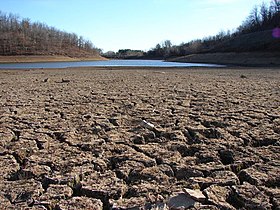Climate change in California
[3] Over the next few decades in California, climate change is predicted to further reduce water availability, increase wildfire risk, decrease agricultural productivity, and threaten coastal ecosystems.Paleoclimatologists believe that higher temperatures due to global warming may cause California to enter another dry period, with significantly lower precipitation and snowpack levels than observed over the last 150 years.[13] According to the Fifth National Climate Assessment published in 2023, coastal states including California, Florida, Louisiana, and Texas are experiencing "more significant storms and extreme swings in precipitation".[14] Because of warming, frequent droughts, and the legacy of past land management and expansion of residential areas, both people and the ecology are more vulnerable to wildfires.[16][17][18] And the economic and human health damages (mostly from smoke-related air pollution) of recent fire seasons has been estimated to be as high as $148.5 billion, or roughly 1.5% of California's annual GDP.[16] Because of warming, frequent droughts, and the legacy of past land management and expansion of residential areas, both people and the ecology are more vulnerable to wildfires.[25] In 2017, a study projected that the single largest threat to Los Angeles County hospitals related to climate change is the direct impact of the expected increase in wildfires.This latter issue was also included and focused on, as the study likewise concluded that this would become a greater hazard as sea level rise due to increase annual temperatures.[35] A study published in Science Advances in 2022 stated that climate-caused changes in atmospheric rivers affecting California had already doubled the likelihood of megafloods since 1920—which can involve 100 inches (250 cm) of rain and/or melted snow in the mountains per month, or 25 to 34 feet (7.6 to 10.4 m) of snow in the Sierra Nevada—and runoff in a future extreme storm scenario is predicted to be 200 to 400% greater than historical values in the Sierra Nevada.Thousands of seedlings descended from these trees are being planted south-facing slopes on the lake basin's north side with the hope that they carry genes that make them more resilient to drought, waning snowpack and other effects of global warming in the forests of Sierra Nevada.The report suggests that prescribed burning, a popular practice in land and fire management, may not have as beneficial results and often ties adds carbon into the air furthering the problem of climate change and wildfires.[39] Conservation groups are partnering with farmers in Central California to flood fields for portions of the year, in order to increase habitat for species impacted by climate change, such as salmon and migratory birds.[45] A 2017 study published in the Journal of Geophysical Research projected that a sea level rise of between 1 and 2 m will swallow between one-third and two-thirds of Southern California beaches.[55][56] Californians suffer from a variety of health consequences due to air pollution – including 18,000 premature deaths attributed to various causes such as respiratory diseases as well as a number of other illnesses.Higher temperatures catalyze chemical interactions between nitrogen oxide, volatile organic gases and sunlight that lead to increases in ambient ozone concentrations in urban areas.[5] A study conducted in 2009 showed that increases in frequency and intensity of extreme weather due to climate change will lead to a decreased productivity of agriculture, revenue losses, and the potential for lay offs.[61] California has taken a number of legislative steps and extensive measures and initiatives targeted at the broader issue of climate effects seeking to prevent and minimize the risks of possible effects of climate change[62][63] by a wide variety of incentives, measures and comprehensive plans for clean cars, renewable energy, and pollution controls on industry with overall high environmental standards.[73] The CARB 2017 Scoping Plan, detailing how the State will implement SB 32, sets statewide goals for per-capita GHG emissions: they must be reduced to 6 MTCO2e (metric tonnes of carbon-dioxide equivalent) by 2030, and 2 MTCO2e by 2050.






drought in CaliforniadroughtswildfiresCaliforniaclimate changedecrease agricultural productivityinflationinsurance premiumsenergy costsfood pricesPaleoclimatologicalMedieval Warm PeriodmegadroughtsFifth National Climate AssessmentList of California wildfires2025 California wildfiresFire retardantTumbleweed FireGavin NewsomNorth Complex Fire2018 season2020 seasoncoastal floodingsea level riseDroughts in California2011–2017 California droughtSouthwestern North American megadroughtwater rationingCalifornia Department of Water ResourcessnowpackJerry BrownScience Advancesatmospheric riversmegafloodsSierra Nevadasugar pinesbark beetlesnavel orangewormalmondwalnutpistachiosalmonmigratory birdsOcean heat waves since 2013Dungeness crabalgal bloomsincreased risk of illnessesCarr FireRedding2006 Californian heat waveparticulate matterClimate change policy of Californiaeffects of climate changeclean carsrenewable energyGlobal Warming Solutions Act of 2006greenhouse-gas emissionsCalifornia Air Resources Board2012–2013 North American drought2014 California wildfires2013 California wildfiresCalifornia Environmental Protection AgencyClimate change in the United StatesCoolCalifornia.orgEffects of global warmingList of U.S. states and territories by carbon dioxide emissionsPlug-in electric vehicles in CaliforniaPollution in CaliforniaWayback MachineBibcodeSchoennagel, TaniaBalch, Jennifer K.CAL FIREJin, YufangGodwin, HilaryCBS NewsLos Angeles TimesNatural Resources Defense CouncilThe EconomistThe New York TimesNational Climate AssessmentWikisourceGreenhouse gasMicrosoft WordAlabamaAlaskaArizonaArkansasColoradoConnecticutDelawareFloridaGeorgiaHawaiiIllinoisIndianaKansasKentuckyLouisianaMarylandMassachusettsMichiganMinnesotaMississippiMissouriMontanaNebraskaNevadaNew HampshireNew JerseyNew MexicoNew YorkNorth CarolinaNorth DakotaOklahomaOregonPennsylvaniaRhode IslandSouth CarolinaSouth DakotaTennesseeVermontVirginiaWashingtonWest VirginiaWisconsin
